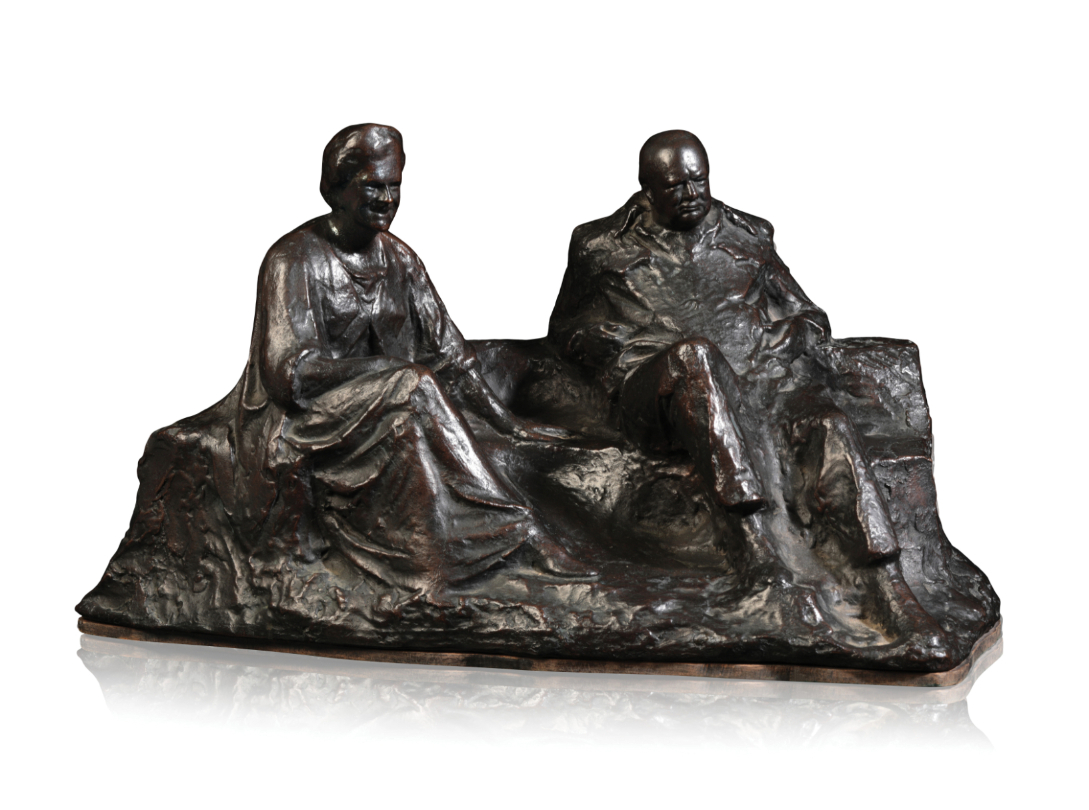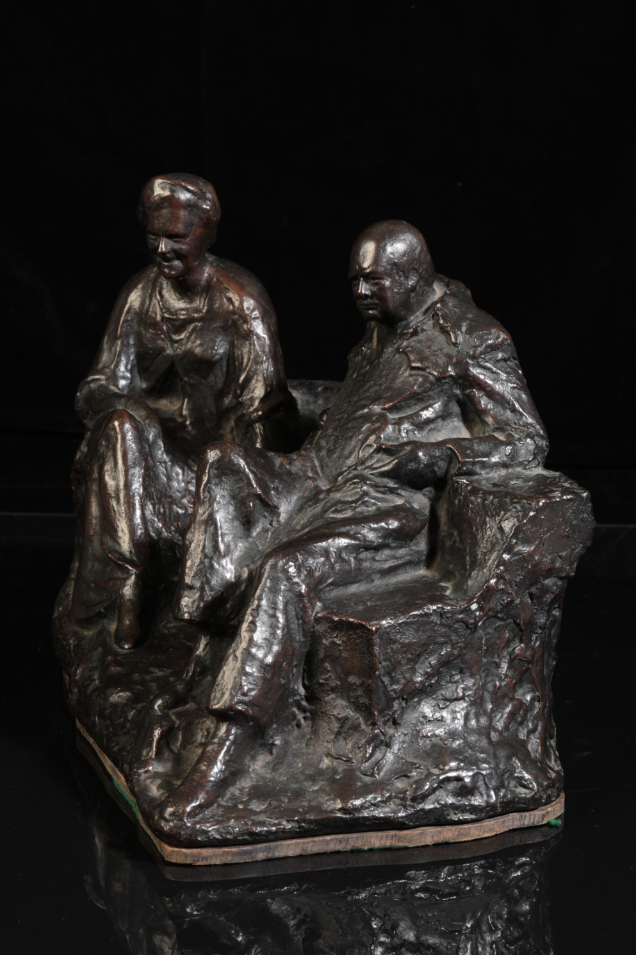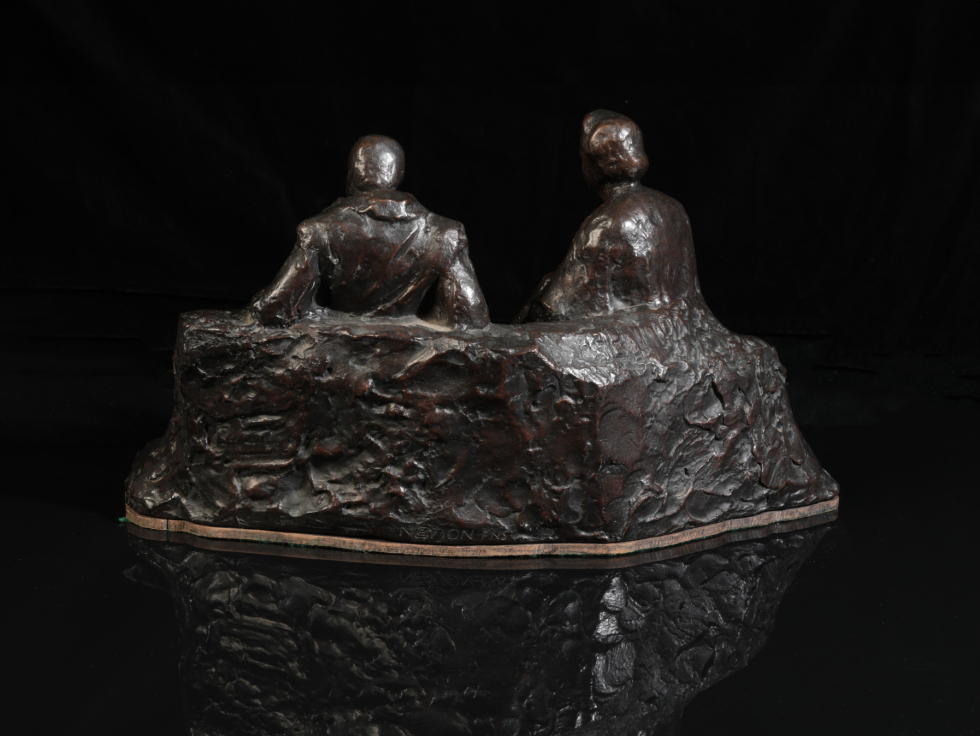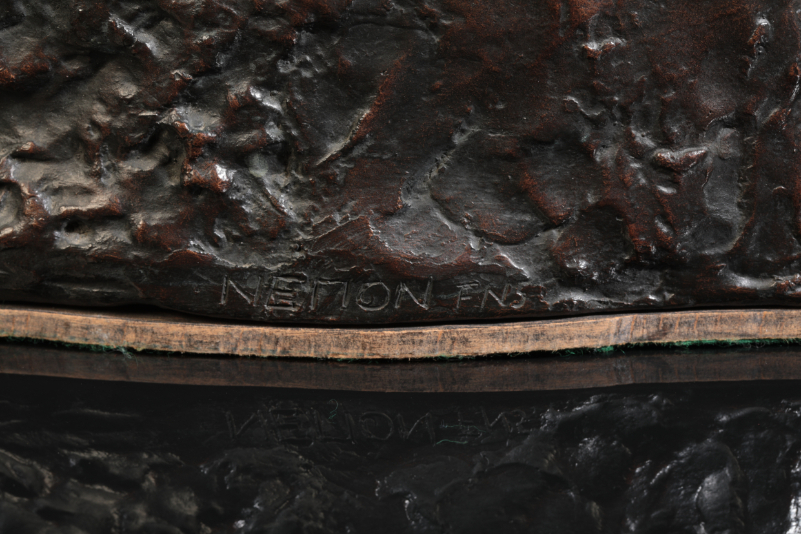57
*OSCAR NEMON (1906-1985) 'Married Love'
In 200 Years
200 Years
Sale Date(s)
Venue Address
General delivery information available from the auctioneer
We are pleased to recommend reputable carriers and can advise on air-freight and other forms of despatch. Items of furniture not collected within 5 working days will be transported to storage at the buyers expense.
Important Information
Payments
Payments are to be made in British pounds (£GBP), by these payment methods please:
a) Credit card: accepted without limit in person, for telephone payments by credit card, there is a limit of £500 (total invoice amount)
b) Debit card: accepted without limit in person and by telephone
c) Bank transfer (BACS): Duke's Auctioneers bank account details are stated on the invoice, please reference the payment with the invoice number and auction number (as shown on the invoice)
d) Online: payment can be made via your Duke's account on www.dukes-auctions.com using a card of your choice, a payment fee of 1.95% is charged.
Due to problems with fraudulent debit and credit card transactions, payments over the telephone cannot be made for invoices totalling more than £500 unless the Buyers are known to Duke's. Payment can be made in person using a chip and pin number, bank transfer, or cash up to £9,000.
Please note that invoices will be sent out the day after the completion of the sale.
Unfortunately, Duke's are unable to offer a postal or delivery service. We are pleased to recommend reputable carriers and can advise on air-freight and other forms of despatch.
PLEASE NOTE: Items of furniture not collected within 5 working days will be transported to storage at the buyer's expense. Please contact us for more details.
Buyer's Premium 25% + VAT
Lots purchased via the-saleroom.com live auction service will be subject to an additional 4.95% commission charge + VAT at the rate imposed.
Lots marked with an asterisk are eligible for Droit de Suite
Terms & Conditions
Glossary of Cataloguing Terms
The auctioneers are always pleased to discuss individual lots with prospective purchasers prior to the auction and will provide condition reports on request. Please bear in mind however, that condition reports are subjective and we earnestly request potential purchaser to inspect personally any lot on which they intend to bid. Descriptions of property in this catalogue do not always indicate condition, repair or damage.
Use of inverted commas around a word, or phrase indicates that the piece, or object, may not be what it is purporting to be, or may be an old-fashioned term of art no longer in use. If you are in doubt, our specialists are available prior to the auction to offer guidance and advice. With Chinese ceramics and works of art, if the catalogue states that an object in question bears a mark, but does not state ‘and of the period’, it indicates that we believe the lot in question may not date from the period suggested by the mark. Clearly, references to the colour of jade are subjective and again, buyers are advised to inspect personally any items on which they intend to bid to ensure the colour meets with their expectation.
Weights and measurements are all approximate and should be verified by intending purchasers.
Care is taken to ensure that any statements as to authorship, attribution, origin, date, provenance is reliable and accurate, but such statements are statements of opinion and not to be taken as statements or representations of fact. Duke’s reserve the right, in forming their opinion, to consult and rely upon any expert, or authority, reasonably considered by them to be reliable.
The term basically used in conjunction with a date (ie. basically 18th century) indicated that, in our opinion, the item may .have undergone restoration, repair, or alternation. It also indicates that only an element of the piece may date from the period stated in the description. The absence of the term basically does not imply that an item is without restoration, repair, or alternation.
Paintings, Drawings and Prints
A work catalogued with the forenames(s) and surname of recognised designation of an artist is, in our opinion, a work by the artist, e.g. NICHOLAS CHEVALIER
Attributed to NICHOLAS CHEVALIER
. . . in our opinion a work of the period of the artist which may be in whole or in part the work of the artist.
Studio of NICHOLAS CHEVALIER
. . . in our opinion a work by an unknown hand, which may have been executed in the studio of the artist.
Circle of NICHOLAS CHEVALIER
. . . in our opinion a work from the period of the artist and showing his influence.
Follower of NICHOLAS CHEVALIER
. . . in our opinion a work executed in the style of the artist but not necessarily by a pupil.
Manner of NICHOLAS CHEVALIER
. . . in our opinion a work of the artist but of a later date.
After NICHOLAS CHEVALIER
. . . in our opinion a copy of any date after a work by the artist.
Signed/inscribed/date NICHOLAS CHEVALIER
. . . in our opinion the work has been signed/inscribed/dated by the artist.
Bears signature/inscription/date NICHOLAS CHEVALIER
. . . in our opinion the signature/inscription/date are probably not by the hand of the artist.
The addition of a question mark after any of the catalogue terms in the above gloassary indicates an element of doubt.
The term 'ascribed to' may in certain cases be used to denote a traditional attribution based on style.
A work catalogued as 'School' accompanied by the name of a place or country and a date mean that in our opinion the work was executed at that time and in that location, e.g. Dutch school, circa 1700.
All reference to signatures, inscriptions and dates refer to the present state of work, i.e. as at the time of inspection for the purpose of cataloguing.
The use of inverted comas around the name of an artist, or date, in connection with a signature, or inscription (ie. Signed "Nicholas Chevalier") indicates that the signature, or inscription, may have been added by another hand.
Artist's Resale Right
From mid February 2006 living artists are entitled by law to receive a resale royalty each time their work is resold by or to an art market professional. An art work must be resold for more than 1,000 Euros to qualify for the right. The rates payable are calculated as a percentage of the hammer price and are set out in a sliding scale from 4% to 0.25%. The charge is exclusive of VAT. The auctioneers reserve the right to pass all of the cost to the person buying the qualifying art work.
Coloured Gem Stones
Prospective buyers of coloured gemstones should be aware that some stones might have been treated to enhance their colour or clarity. Sapphires and rubies are commonly heat-treated and emeralds are commonly oiled. In the case of oiling, this may need to be redone after a period of years. The international jewellery trade has generally accepted these methods.
Conditions of Sale
Duke's carries on business with bidders, buyers and all those present in the auction room prior to or in connection with a sale on the following General Conditions and on such other terms, conditions and notices as may be referred to herein.
1. Definitions
In these Conditions:
a. "auctioneer" means the firm of Duke's or its authorised auctioneer, as appropriate;
b. "deliberate forgery" means an imitation made with the intention of deceiving as to authorship, origin, date, age, period, culture or source but which is unequivocally described in the catalogue as being the work of a particular creator and which at the date of sale has a value materially less than it would have had if it had been in accordance with the description;
c. "hammer price" means the level of bidding reached (at or above any reserve) when the auctioneer brings down the hammer;
d. "terms of consignment" means the stipulated terms and rates of commission on which Duke's accepts instruction from the sellers or their agents;
e. "total amount due" means the hammer price in respect of the lot sold together with any premium, Value Added Tax chargeable and any additional charges payable by a defaulting buyer under these Conditions;
f. "sale proceeds" means the net amount due to the seller, being the hammer price of the lot sold less commission at the started rate, Value Added Tax chargeable and any other amounts due to us by the seller in whatever capacity and however arising;
g. "you", "your", etc. refer to the buyer as identified in Condition 2.
h. The singular includes the plural and vice versa as appropriate
2. Bidding Procedures And The Buyer
a. Bidders are required to register their particulars before bidding and to satisfy any security arrangements before entering the auction room to view or bid;
b. the maker of the highest bid accepted by the auctioneer conducting the sale shall be the buyer at the hammer price and any dispute about a bid shall be settled at the auctioneer's absolute discretion by reoffering the Lot during the course of the auction or otherwise. The auctioneer shall act reasonably in exercising the discretion.
c. Bidders shall be deemed to act as principles
d. Once made, no bid may be withdrawn
e. Our right to bid on behalf of the seller is expressly reserved up to the amount of any reserve and the right to refuse any bid is also reserved.
3. Increments
Bidding increments shall be at the auctioneer's sole discretion.
4. The Purchase Price
The buyer shall pay the hammer price together with a premium thereon of 25% plus VAT on the premium at the rate imposed by law.
5. Value Added Tax
Value Added Tax on the hammer price is imposed by law on all items affixed with an asterisk or double asterisk. Value Added Tax is chargeable at the appropriate rate prevailing by law at the date of sale and is payable by buyers of relevant Lots. *VAT payable at 5.00% on the hammer price and 20% on the buyers premium.
6. Payment
1. Immediately a Lot is sold you will:
a. give to us, if requested, proof of identity, and
b. pay to us the total amount due in cash or in such other wats as is agreed by us.
2. Any Payments by you to us may be applied by us towards any sums owing from you to us on any account whatever without regard to any direction of you or your agent, whether express or implied.
7. Title And Collection Of Purchases
0. The ownership of any Lots purchased shall not pass to you until you have made payment in full to us of the total amount due.
1. You shall at your own risk and expense take away any lots that you have purchased and paid for not later than 5 working days following the day of the auction or upon the clearance of any cheque used for payment after which you shall be responsible for any removal, storage and insurance charges.
2. No purchase can be claimed or removed until it has been paid for.
8. Remedies For Non-Payment Or Failure To Collect Purchased
0. If any Lot is not paid for in full and taken away in accordance with the Conditions or if there is any other breach of the Condition, we, as agent for the seller and on our own behalf, shall at our absolute discretion and without prejudice to any other rights we may have, be entitled to exercise one or more of the following rights and remedies:
a. to proceed against you for damages for breach of contract;
b. to rescind the sale of that Lot and/or any other Lots sold by us to you;
c. to resell the Lot (by auction or private treaty) in which case you shall be responsible for any resulting deficiency in the total amount due (after crediting any part payment and adding any resale costs). Any surplus so arising shall belong to the seller;
d. to remove, store and insure the Lot at your expense and, in the case of storage, either at our premises or elsewhere;
e. to charge interest at a rate not exceeding 1.5% per month on the total amount due to the extent it remains unpaid for more than 3 working days after the sale;
f. to retain that or any other Lot sold to you until you have to total amount due;
g. to reject or ignore bid from you or your agent at future auctions or to impose condition before any such bids shall be accepted;
h. to apply any proceeds of sale of other Lots due or in future becoming due to you towards the settlement of the total amount due and to exercise a lien (that is a right to retain possession of) any of your property in our possession for any purpose until the debt due is satisfied.
1. We shall, as agent for the seller and on our own behalf pursue these rights and remedies only so far as is reasonable to make appropriate recovery in respect of breach of these conditions
9. Third Party Liability
All members of the public on our premises are there at their own risk and must note the lay-out of the accommodation and security arrangements. Accordingly neither the auctioneer nor our employees or agents shall incur liability fir death or personal injury (exept as required by law by reason of our negligence) or similarly for the safety of the property or persons visiting prior to or at a sale.
10. Commission Bids
Whilst prospective buyers are strongly advised to attend the auction and are always responsible for any decision to bid for a particular Lot and shall be assumed to have carefully inspected and satisfied themselves as to its condition we will if so instructed clearly and in writing execute bids on their behalf. Neither the auctioneer nor our employees or agents shall be responsible for any failure to do so save where such failure is unreasonable. Where two or more commission bids at the same level are recorded we reserve the right in our absolute discretion to prefer the first bid so made.
11. Warranty Of Title And Availability
The seller warrants to the auctioneer and you that the seller is the true owner of the property consigned or properly authorised by the true owner to consign it for sale and is able to transfer good and marketable title to the property free from any third party claims.
12. Agency
The auctioneer normally acts as agent only and disclaims any responsibility for default by sellers or buyers.
13. Terms Of Sale
The seller acknowledges that Lots are sold subject to the stipulations of these Conditions in their entirety and on the Terms of Consignment as notified to the consignor at the time on the entry of the Lot.
14. Descriptions And Condition
0. Whist we seek to describe lots accurately, it may be impractical for us to carry out exhaustive due diligence on each lot. Prospective buyers are given ample opportunities to view and inspect before any sale and they (and any independent experts on their behalf) must satisfy themselves as to the accuracy of any description applied to a lot. Prospective buyers also bid on the understanding that, inevitably, representations or statements by is as to authorship, genuineness origin date, age, provenance, condition honesty and reasonably held and accept liability for opinions given negligently or fraudulently. Subject to the foregoing neither we the auctioneer nor our employees or agents nor the seller accept liability for the correctness of such opinions and all conditions and warranties, whether relating to description, condition or quality of lots, express, implied or statutory, are hereby excluded. This Condition is subject to the next following Condition concerning deliberate forgeries and applies save as provided for in paragraph 6 "information to buyers".
1. Private treaty sales made under these Condition are deemed to be sales by the auction for purposes of consumer legislation.
15. Forgeries
Notwithstanding the preceding Condition, any Lot which proves to be a deliberate forgery (as defined) may be returned to us by you within 21 days of the auction provided it is in the same condition as when bought, and is accompanied by particulars identifying it from the relevant catalogue description and a written statement of defects. If we are satisfied from the evidence presented that the Lot is a deliberate forgery we shall refund the money paid by you for the Lot including any buyer's premium provided that
0. if the catalogue reflected the accepted view of scholars and experts as at the date of sale or
1. you personally are not able to transfer a good and marketable title to us, you shall have no rights under this condition.
The right of return provided by this Condition is additional to any right or remedy provided by law or by these Conditions of Sale.
16. General
We shall have the right at our discretion, to refuse admission to our premises or attendance at our auctions by any person.
0. any right to compensation for losses liabilities and expenses incurred in respect of and as a result of any breach of these Conditions and any exclusions provided by them shall be available to the seller and/or the auctioneer as appropriate.
1. Such rights and exclusions shall extend to and be deemed to be for the benefit of employees and agents of the seller and/or the auctioneer who may themselves enforce them.
2. Any notice to any buyer, seller, bidder or viewer may be given by first class main or Swiftmail in which case it shall be deemed to have been received by the addressee 48 hours after posting.
3. Special terms may be used in catalogue descriptions of particular classes of items in which case the description must be interpreted in accordance with any glossary appearing at the commencement of the catalogue.
4. Any indulgence extended to bidders, buyers or sellers by us notwithstanding the strict terms of these Conditions or of the Terms of Consignment shall affect the position at the relevant time only and in respect of that particular concession only; in all other respects these Conditions shall be constructed as having full force and effect.
5. English law applies to the interpretation of these Conditions.
Live Bidding
Duke’s Auctioneers offer an online bidding service via the-saleroom.com for bidders who cannot attend the sale.
In completing the bidder registration on www.the-saleroom.com and providing your credit card details and unless alternative arrangements are agreed with Duke’s Auctioneers you:
1. authorise Duke’s Auctioneers, if they so wish, to charge the credit card given in part or full payment, including all fees, for items successfully purchased in the auction via the-saleroom.com, and
2. confirm that you are authorised to provide these credit card details to Duke’s Auctioneers through www.the-saleroom.com and agree that Duke’s Auctioneers are entitled to ship the goods to the card holder name and card holder address provided in fulfilment of the sale.
3. Buyers registering to bid through saleroom.com must submit credit/debit card details to register. Duke’s at it’s discretion, will take a deposit of maximum £500 sterling from the registered credit /debit card. If the buyer is unsuccessful this deposit will be refunded. If successful the deposit will be taken off the invoice.
IMPORTANT: The deposit will be subject to variables in exchange rates and bank charges that the buyers bank might levy. Duke’s will not be liable for these charges.
Please note that any lots purchased via the-saleroom.com live auction service will be subject to an additional 4.95% commission charge + VAT at the rate imposed on the hammer price. Clicking the bid button is a commitment to buy.















